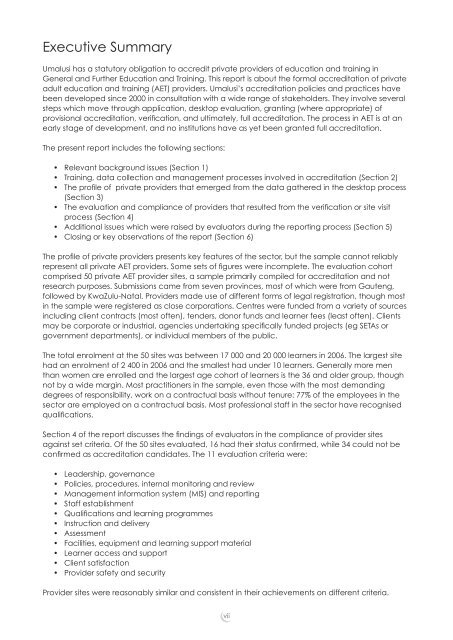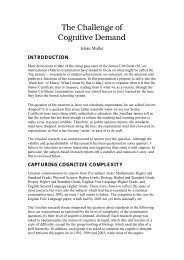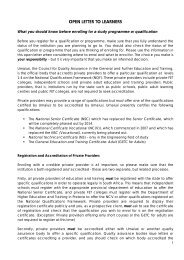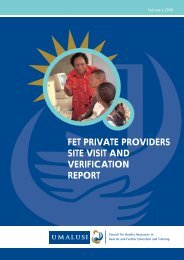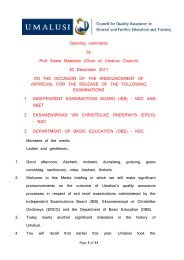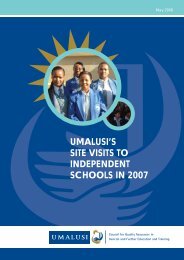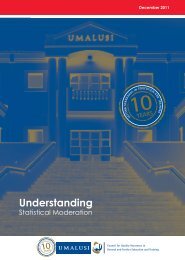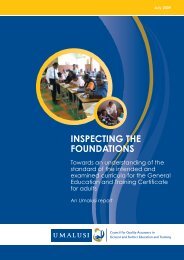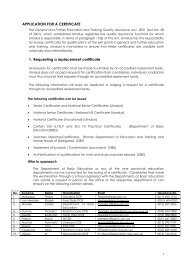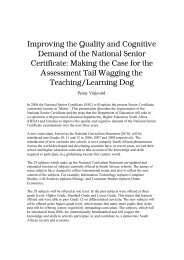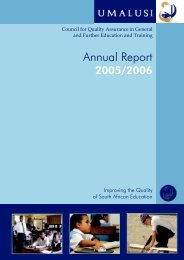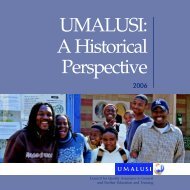Umalusi AET Report
Umalusi AET Report
Umalusi AET Report
- No tags were found...
Create successful ePaper yourself
Turn your PDF publications into a flip-book with our unique Google optimized e-Paper software.
Executive Summary<strong>Umalusi</strong> has a statutory obligation to accredit private providers of education and training inGeneral and Further Education and Training. This report is about the formal accreditation of privateadult education and training (<strong>AET</strong>) providers. <strong>Umalusi</strong>’s accreditation policies and practices havebeen developed since 2000 in consultation with a wide range of stakeholders. They involve severalsteps which move through application, desktop evaluation, granting (where appropriate) ofprovisional accreditation, verifi cation, and ultimately, full accreditation. The process in <strong>AET</strong> is at anearly stage of development, and no institutions have as yet been granted full accreditation.The present report includes the following sections:• Relevant background issues (Section 1)• Training, data collection and management processes involved in accreditation (Section 2)• The profi le of private providers that emerged from the data gathered in the desktop process(Section 3)• The evaluation and compliance of providers that resulted from the verifi cation or site visitprocess (Section 4)• Additional issues which were raised by evaluators during the reporting process (Section 5)• Closing or key observations of the report (Section 6)The profi le of private providers presents key features of the sector, but the sample cannot reliablyrepresent all private <strong>AET</strong> providers. Some sets of fi gures were incomplete. The evaluation cohortcomprised 50 private <strong>AET</strong> provider sites, a sample primarily compiled for accreditation and notresearch purposes. Submissions came from seven provinces, most of which were from Gauteng,followed by KwaZulu-Natal. Providers made use of different forms of legal registration, though mostin the sample were registered as close corporations. Centres were funded from a variety of sourcesincluding client contracts (most often), tenders, donor funds and learner fees (least often). Clientsmay be corporate or industrial, agencies undertaking specifi cally funded projects (eg SETAs orgovernment departments), or individual members of the public.The total enrolment at the 50 sites was between 17 000 and 20 000 learners in 2006. The largest sitehad an enrolment of 2 400 in 2006 and the smallest had under 10 learners. Generally more menthan women are enrolled and the largest age cohort of learners is the 36 and older group, thoughnot by a wide margin. Most practitioners in the sample, even those with the most demandingdegrees of responsibility, work on a contractual basis without tenure: 77% of the employees in thesector are employed on a contractual basis. Most professional staff in the sector have recognisedqualifi cations.Section 4 of the report discusses the fi ndings of evaluators in the compliance of provider sitesagainst set criteria. Of the 50 sites evaluated, 16 had their status confi rmed, while 34 could not beconfi rmed as accreditation candidates. The 11 evaluation criteria were:• Leadership, governance• Policies, procedures, internal monitoring and review• Management information system (MIS) and reporting• Staff establishment• Qualifi cations and learning programmes• Instruction and delivery• Assessment• Facilities, equipment and learning support material• Learner access and support• Client satisfaction• Provider safety and securityProvider sites were reasonably similar and consistent in their achievements on different criteria.vii


